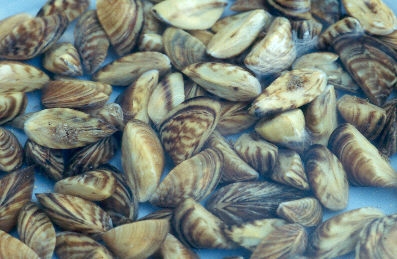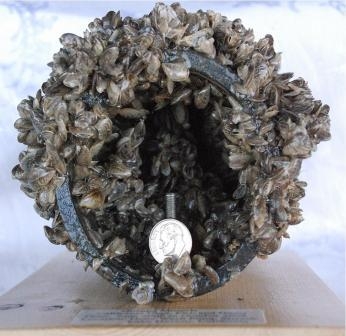Posts Tagged: quagga mussels
Zebra mussels and quagga mussels threaten California water systems
Some of California’s many introduced species — plants, animals, insects, and aquatic organisms — have marked impacts on ecological systems.
Invasive aquatic organisms can impact fish, shorebirds, marsh plants, and other wetland species, and alter functions of lakes, watersheds, floodplains, and coastal ecosystems.
Estuarine ecologist Ted Grosholz, a UC Davis professor and Cooperative Extension specialist in the Department of Environmental Science and Policy, is an expert on invasive species and addresses outreach education on zebra mussels and quagga mussels.
These two invasive, freshwater Eurasian mussels—zebra mussels and quagga mussels — could have a profound impact on California’s lakes and water distribution systems.
Both quarter-sized mussels showed up in California about six years ago. They attach themselves to water conveyance systems — pumps, pipes, dams, aqueducts, and fish hatcheries — and proliferate. According to Grosholz, “our drinking water and agricultural irrigation systems could be shut down quickly by these organisms.”
Los Angeles water districts are coping with the mussels, which are in Southern California watersheds, and reservoirs and canals of the Colorado River. The larval stage of the mussels disperses readily in water, so it gets moved around easily. There is tremendous concern about their potential spread into Lake Tahoe, and they have recently shut down a reservoir near San Jose. These mussels have cost the state tens of millions of dollars.
Zebra and quagga mussels pose a serious ecological threat in California. In the Great Lakes, where they became established 25 years ago, they have removed phytoplankton — a food source for juvenile fish — thereby impacting the food web. They have also concentrated the environmental contaminant botulism, resulting in massive kills of diving ducks and shorebirds.
Aquatic invasive species are moved long distances by ships — in ballast water, hulls and attached to ships’ surfaces. Within California they can be moved by recreational and fishing boats, trailers and other equipment.
“Once aquatic species are introduced, the cat is out of the bag — they spread easily, and they’re very difficult to control,” notes Grosholz.
Since the state doesn’t have the resources to adequately enforce zebra and quagga mussel control, areas such as Clear Lake and Fallen Leaf Lake are establishing local mandatory vehicle and boat inspection programs.
Grosholz works closely with resource agencies and other organizations to develop programs aimed at identifying and reducing the spread of invasive aquatic organisms. “It’s important to increase awareness of these species because they’re such a problem,” says Grosholz. “Their impact on ecosystems is big, and early control is very important.”
To read more about invasive aquatic species, including zebra and quagga mussels, see:
CA&ES Outlook magazine, pages 4–7
Quagga/Zebra Mussel Invasion, UC Cooperative Extension Coastal Resources
Quagga and Zebra Mussels, California Dept. of Fish and Game
Quagga and Zebra Mussel Prevention Program, San Luis Obispo County, California
Quagga and Zebra Mussel, Calif. Dept. of Boating and Waterways




